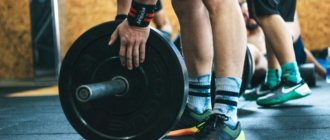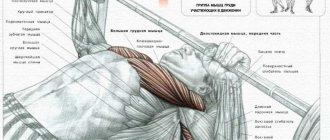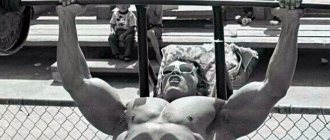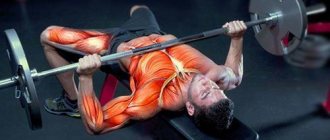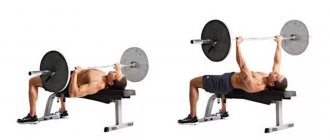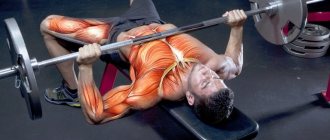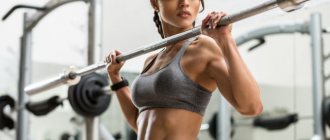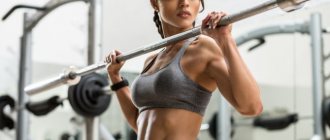Photo
There are periods of off-season when training for a strongman is similar to training for a bodybuilder. The goals and objectives partly coincide - general mass gain, development of lagging muscle groups, only as the competition approaches, the arsenal of additional exercises of the strength officer changes, the number of repetitions decreases, the weights increase. The higher the class of a strongman, the more pronounced the division of the training cycle into phases, the wider his arsenal of auxiliary exercises should be.
Why does the bench press need an auxiliary?
The bench press is one of the fundamental exercises for both relief and mass training. However, every athlete has certain muscles that are stronger than others. This means that when you pass a certain threshold in the weight of the barbell, you will not have enough effort at the bottom, middle or highest point of the amplitude of the press movement. That is why both professionals and amateurs use additional exercises designed to develop muscles harmoniously, so that there are no distortions in the strength of the muscles of the upper half of the body and in appearance.
No. 1 Front pull with shrug element
This exercise was first performed by Kirk Karwoski, a famous powerlifter. Thus, he wanted to increase his grip strength. The lifter's trainer, Marty Gallagher, believed that with the addition of this component, Kirk's deadlift weight would increase.
He was not mistaken, because the athlete reached almost 363 kg. In addition, both noticed that the trapezius also developed well from the movement.
The exercise technique is similar to barbell rows and shrugs. The athlete takes the projectile slightly narrower than the shoulders and begins the movement by raising the elbows and shoulders upward, while shaking them.
The movement is also performed in a crossover.
In essence, we can say that this is an incorrect traction technique for the deltoids, involving the trapezius.
The fundamental difference is that the exercise begins with raising the elbows, but the barbell is not reached higher than the waist. At the top point, the trapezoids are squeezed, as in classic shrugs.
The amplitude is too small to load the shoulders, and the emphasis here is on holding the projectile in the hands and working the trapezius.
Shrugging his shoulders, the athlete develops ramps for his deadlift and forms a so-called “shelf” for the weight when squatting.
A powerful trapezius is needed to stabilize the shoulders with a heavy barbell. It is on the upper back that the weight is placed. And the strength of the forearms guarantees a strong grip.
The exercise can be performed at the end of a back workout in three sets of 8-12 repetitions.
Muscles that need to be strengthened
During the bench press, the pectoralis major muscle takes on the bulk of the work. It is helped by the triceps brachii, as well as the anterior and middle parts of the deltoid muscle. An undeveloped triceps will slow down the exercise at the top point of the movement, weak deltoids will complicate the start of the press. In addition, the grip affects the execution of the exercise. As it expands, more load falls from the triceps to the pectoral muscle. But at the same time, the amplitude of movement during the press also decreases.
Now it makes sense to start studying exercises that will help you reach the desired weight in the bench and overcome stagnation.
How to increase your bench press by 10 kg?
Any bench press program that results in increased strength is based on cycling. All changes in the body have a wave nature.
Probably, many have noticed periods of increased strength and, on the contrary, decline. When building a training program, you can take advantage of the biological rhythms of your body.
Moreover, professional athletes themselves “rebuild” their body and bring it to its peak for competitions. Amateurs don't need to do this. But you can take advantage of such “developments”. Especially if the goal is to increase strength indicators.
IMPORTANT: There are many bench press cycles. They come in long and short. Beginners can use short cycles at the first stage. Then, if they lead to stagnation, change the cycle to another.
The simplest cycle is the 5X5 system (five sets of five reps) with a weekly increase in weight on the bar by 2.5 kg. After 5-6 weeks, you need to “roll back” from the maximum weight by 10 kg and start all over again.
This is the simplest cycle, but it is suitable for both beginners and advanced athletes.
Recommended auxiliary exercises
Incline press
This press is performed with both a positive and negative incline.
The positive incline press utilizes more of the upper chest and deltoid muscle resources, creating a kind of “fan-shaped” structure with a fairly low amount of subcutaneous fat.
With a negative tilt, the lower part of the pectoral muscle works, the pectoralis minor muscle works more, as well as the iliacus muscles. This type of press helps in the lower push-out phase of a regular press and serves to create definition in this area.
French press and close grip press
Such exercises will help you get the largest muscle in your arm, the triceps, out of stagnation. When pressing with a narrow grip, the emphasis shifts not only to the triceps, but also to the inner part of the pectoral muscle, giving it volume.
The French press is also a good workout for the triceps, but the emphasis is on the long head of the triceps. It provides more insulation than a sloped one. It can be performed with an incline EZ bar or a regular Olympic bar.
Lying dumbbell flyes
This exercise isolates the pectoral muscle well and is great for a “clogging” exercise at the end of a workout, when the concentration of lactic acid in the muscle tissue is maximum. Performed on a downward or upward inclined and horizontal bench, focusing on the middle, upper or lower chest.
Pullover
This exercise develops a large number of stabilizer muscles, deltoids, pectoral muscles and statically loads the triceps. This exercise can be done with either heavy dumbbells or a barbell. The athlete lies down on a straight horizontal bench, the apparatus is placed perpendicular to the body and placed behind the head. The hands take a horizontal position at the lowest point, then the dumbbell or barbell smoothly rises to its original position.
Dumbbell Bench Press
An excellent alternative to the classic bench press is the dumbbell press. It is performed similarly to the version with a barbell.
Bench press: tips and reviews
Oleg. I train using the 5X5 system. That is, five sets of five repetitions. I try to gain 2.5 kg every next week. I do two bench press workouts a week. In addition, they do deadlifts and squats.
Igor. I train according to the Sheiko system. He easily hit Sotka with his own weight of 75 kg. I took creatine and now took a break. But he resisted. Strength does not increase not only on the bench press, but also in other exercises. I consulted with the guys. They said to take a break and start again, slightly reducing the maximum result from which the report will be based.
Recommended number of approaches for assisting
For the main exercise, it is recommended to do 8-10 repetitions in three main sets. At the same time, don’t forget to do three warm-up exercises with the bar, 50% and 80% of the working weight. For good results in auxiliary movements, take less weight and do 10-15 repetitions with great effort in four approaches. Here you need to try to mentally feel and highlight each muscle, how it is tensed and how blood flows through it.
Regarding the incline press, it is worth saying that here you should follow the bench press pattern.
How to increase your bench press: training program
After a beginner comes to the gym, he must go through a period of adaptation of the body to training. At this time, you need to hone your technique. You shouldn’t think about results in the first 1-2 months.
But after this time, you can already make training plans and select a program for yourself. There is no universal program for improving your bench press. It all depends on the characteristics of a particular organism.
For beginners who have passed the introductory phase and want to improve their bench press, perhaps the following program is suitable:
- First approach (warm-up) – empty bar x 20 reps
- Second approach - 40 kg for 10 repetitions
- Third approach - 50 kg for 8 repetitions
- Fourth approach - 60 kg for 4-5 repetitions
- Fifth set - 70 kg for 1-2 repetitions
If the weight of the barbell seems light to you, increase it yourself.
You should do two bench press workouts per week. If you work out three times a week, then place a leg or back workout between bench press workouts.
#5 Wide grip deadlift
The wide grip deadlift is reminiscent of the Olympic snatch due to the starting position.
The exercise focuses the load on the back muscles, especially the upper back, which stabilizes the spine in a neutral position during normal deadlifting. By placing your hands wide on the bar, grip strength increases.
The work also involves the lower back, buttocks and forearms.
When using a wide grip, your hips are positioned lower than with a regular deadlift. Breaking away requires more effort, and the movement itself becomes safer. Well suited for those who are slow to take off the projectile from the start.
You can work on the exercise on the day of the deadlift in 3-5 sets of 3-6 repetitions.
#6 Meadows Pull
The exercise reduces the stress on your joints compared to other back rows.
In essence, the movement imitates a dumbbell row, but it puts more strain on the shoulders and develops grip strength (by holding the barbell). You can also load more weights than a dumbbell.
This exercise targets the lats, trapezius, diamonds, rear deltoids and forearms.
Due to the large amplitude, the movement develops the upper back, which helps you safely deadlift heavy weights from the floor.
It also eliminates side imbalance as you work each hand separately.
Perform in 3-4 sets of 6-15 repetitions.
No. 4 Leg bending with a fitball
The exercise aims to strengthen the hip extensors and knee flexors while developing hamstring function.
Due to the fact that the movement is performed with a rolling ball, it becomes more difficult to stabilize the position. This forces the hamstring and gluteal muscles to engage.
Focus on the negative phase and after a while the tendons will be bulletproof.
- To begin, lie down on the mat, stretch your arms along your body, and press your lower back to the floor.
- Place your legs straight on the ball, resting your calves all the way down to your hamstrings. The heels rest against the fitball, and the feet point towards the ceiling
- Lift your pelvis up and bend your legs, rolling the ball and pulling it towards your buttocks
- Get to a position where the angle between your thighs and shins is approximately 70 degrees and straighten your legs, slowly returning to the starting position
This exercise increases speed, neuromuscular coordination and running power.
The movement is suitable as a warm-up before squats and deadlifts, or as a finishing movement after them.
By doing it before squats for 2-3 sets of 12-15 repetitions, you will improve blood flow through the knee joint and warm it up, making the squat more comfortable.
#3 Side Lunges
Many strength exercises target the sagittal plane, which divides the body into the right and left sides. Lateral lunges train the muscles in the front.
The exercise develops the adductor and abductor muscles of the legs, which are often ignored by athletes.
Strong thighs in each area will protect against injury and improve performance in other movements.
Start mastering the movement without weight first:
- Stand straight with your feet slightly narrower than your shoulders, extend your arms in front of you or cross them over your chest
- Take a wide step to the side with your right foot. We transfer the center of gravity to the outstretched leg, which bends at the knee until the thigh is parallel to the floor
- Meanwhile, the left leg remains motionless, its foot firmly pressed into the surface
- Exhale and push your right foot off the floor and return to the starting position.
You can work either with each leg alternately, or first perform a set with one and then the other.
If it’s easy to do with your own weight, pick up a dumbbell, kettlebell, or barbell plate and hold the weight in front of your chest. TRX can also be used.
The exercise loads the quadriceps, gluteal, adductor and abductor muscles of the thighs.
The adductors are considered the “forgotten” muscles when it comes to hip mobility and injury prevention.
Side lunges work this lagging area and also strengthen the knees and back. Taken together, the exercise will have a very big impact on your squat and deadlift results.
Do side lunges on leg day after a heavy base for 3 to 4 sets of 8 to 15 reps.

